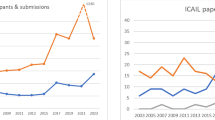Abstract
The way researchers have traditionally measured police action limits their capacity to test legal theories and shed light onto the determinants of law at the initial stage of the criminal justice process. This paper describes extant police action measures and their limitations, offers a new measure that taps variation in the amount of law police officers use in encounters with citizens, presents the results of an analysis that utilizes the new measure, and discusses the implications of this new measure for legal research.
Similar content being viewed by others
References
Aldrich, J. H., and Nelson, F. D. (1984).Linear Probability, Logit, and Probit Models, Sage, Newbury Park, NJ.
Bayley, D. H. (1986). The tactical choices of police patrol officers.J. Crim. Just 14: 329–348.
Bittner, E. (1967). The police on Skid-Row: A study in peace keeping.Am. Sociol. Rev. 32: 699–715.
Black, D. J. (1970). The production of crime rates.Am. Sociol. Rev. 35: 733–748.
Black, D. J. (1976).The Behavior of Law, Academic Press, New York.
Black, D. J. (1979). A mote on the measurement of law.Informationsbrief Rechtssoziol. Sonderheft 2: 92–106.
Black, D. J. (1980).The Manners and Customs of the Police, Academic Press, New York.
Cook, T. D. and Campbell, D. T. (1979).Quasi-experimentation and Analysis Issues for Field Settings, Rand Mcnally, Chicago.
Garner, J., Buchanan, J., Hepburn, J., and Schade, T. (1995). Measuring the use of force by and against the police.Crim. Just. Rev. 20: 146–168.
Fyfe, J. J. (1987).The Metro-Dade Police/Citizen Violence Reduction Project: Final Report, Police Foundation, Washington, DC.
Klinger, D. A. (1994). Demeanor or crime? Why “hostile” citizens are more likely to be arrested.Criminology 32: 201–219.
Klinger, D. A. (1995). The micro-structure of nonlethal force: Baseline data from an observational study.Crim. Just. Rev. 20: 169–186.
Klinger, D. A. (1996a). More on demeanor and arrest in Dade County.Criminology 34: 61–82.
Klinger, D. A. (1996b). Bringing crime back in: Toward a better understanding of police arrest decisions.J. Res. Crime and Del. 33: 333–336.
Lundman, R. J. (1994). Demeanor or crime? The Midwest City police-citizen encounters study.Criminology 32: 331–356.
Lundman, R. J. (1996a). Demeanor and arrest: Additional evidence from previously unpublished data.J. Res. Crime Delinq. 33: 306–323.
Lundman, R. J. (1996b). Extralegal variables and arrests by police.J. Res. Crime Delinq. 33: 349–353.
Mastrofski, S. D., Worden, R. E., and Snipes, J. B. (1995). Law enforcement in a time of community policing.Criminology 33: 539–563.
Muir, W. K. (1977).Police: Streetcorner Politicians, University of Chicago Press, Chicago.
Peterson, T. (1985). A comment on presenting results from logit and probit models.Am. Sociol. Rev. 50: 130–131.
Riksheim, E. C., and Chermak, S. M. (1993). Causes of police behavior revisitedJ. Crim. Just. 21: 353–382.
Sellin, T., and Wolfgang, M. (1964).The Measurement of Delinquency, John Wiley, New York.
Skolnick, J. (1966).Justice Without Trial. John Wiley, New York.
Slovak, J. S. (1987). Police organization and policing environment: Case study of a disjuncture.Sociol. Focus 20: 77–94.
Smith, D. A. (1984). The organizational context of legal control.Criminology 22: 19–38.
Smith, D. A. (1986). The neighborhood context of police behavior. In Reiss, A. J., and Tonry, M. (eds.),Communities and Crime, University of Chicago Press, Chicago.
Smith, D. A. (1987). Police response to interpersonal violence: Defining the parameters of legal control.Soc. Forces 65: 767–782.
Smith, D. A., and Klein, J. R. (1983). Police agency characteristics and arrest decisions. In Whitaker, G. P., and Phillips, C. D. (eds.),Evaluating Performance in Criminal Justice Agencies, Sage, Beverly Hills, CA.
Smith, D. A., and Klein, J. R. (1984). Police control of interpersonal disputes.Soc. Problems 31: 468–481.
Smith, D. A., and Visher, C. A. (1981) Street-level justice: Situational determinants of police arrest decisions.Soc. Problems 29: 167–177.
Smith, D. A., Visher, C. A., and Davidson, L. A. (1984). Equity and discretionary justice: The influence of race on police arrest decisions.J. Crim. Law Criminol. 75: 234–249.
Sykes, R. E., and Brent, E. E. (1983).Policing: A Social Behaviorist Perspective, Rutgers University Press, New Brunswick, NJ.
Visher, C. A. (1983). Gender, police arrest decisions, and notions of chivalry.Criminology 21: 5–28.
Walsh, A. (1987). Teaching understanding and interpretation of logit regression.Teach. Sociol. 15: 178–183.
Wilson, J. Q. (1968).Varieties of Police Behavior, Harvard University Press, Cambridge, MA.
Worden, R. E. (1989). Situational and attitudinal explanations of police behavior: A theoretical reappraisal and empirical assessment.Law Soc. Rev. 23: 667–711.
Worden, R. E., and Politz, A. (1984). Police arrests in domestic disturbances: A further look.Law Soc. Rev. 18: 105–119.
Worden, R. E., and Shepard, R. L. (1996). Demeanor, crime, and police behavior: A reexamination of the Police Services Study data.Criminology 34: 83–105.
Author information
Authors and Affiliations
Rights and permissions
About this article
Cite this article
Klinger, D.A. Quantifying law in police-citizen encounters. J Quant Criminol 12, 391–415 (1994). https://doi.org/10.1007/BF02354425
Issue Date:
DOI: https://doi.org/10.1007/BF02354425




